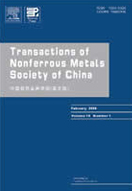Wear behavior and dry sliding tribological properties of ultra-fine grained Al5083 alloy and boron carbide-reinforced Al5083-based composite at room and elevated temperatures
(1. Department of Composites, Malek-Ashtar University of Technology, Tehran, Iran;
2. Department of Materials and Manufacturing Processes, Malek-Ashtar University of Technology, Tehran, Iran;
3. Metallic Materials Research Center, Malek-Ashtar University of Technology, Tehran, Iran)
2. Department of Materials and Manufacturing Processes, Malek-Ashtar University of Technology, Tehran, Iran;
3. Metallic Materials Research Center, Malek-Ashtar University of Technology, Tehran, Iran)
Abstract: Tribological behavior and wear mechanisms of mechanically milled Al5083 alloy and Al5083-5wt.%B4C composite at room temperature and 200 °C were discussed. Results revealed that due to the oxidative wear at room temperature, a mechanically mixed layer (MML) was formed to protect the surface of the samples. Under 80 N of load at room temperature, the milled Al5083 and the Al5083-5wt.%B4C samples showed evidence of abrasion with limited volume loss. In this case, the wear rates were 5.8×10-7 and 4.4×10-7 mm3/(m·N), respectively. At 200 °C and under 80 N of applied load, severe wear occurred in the milled Al5083 sample, and wear rate reached 10.8×10-7 mm3/(m·N) while the Al5083-5wt.%B4C sample showed mild wear with local 3-body abrasion and the wear rate reached 5.3×10-7 mm3/(m·N). Strengthening mechanisms such as dislocation pinning and the Hall-Petch theory, high hardness and the load transfer effect were crucial in determining the wear behavior of the Al5083-5wt.%B4C composite. On the other hand, the milled Al5083 sample represented a relatively high wear rate at 200 °C, which seemed to be related to the local grain growth and a drop in its hardness.
Key words: tribological behavior; oxidative wear; mechanically mixed layer; wear rate; Hall-Petch theory

